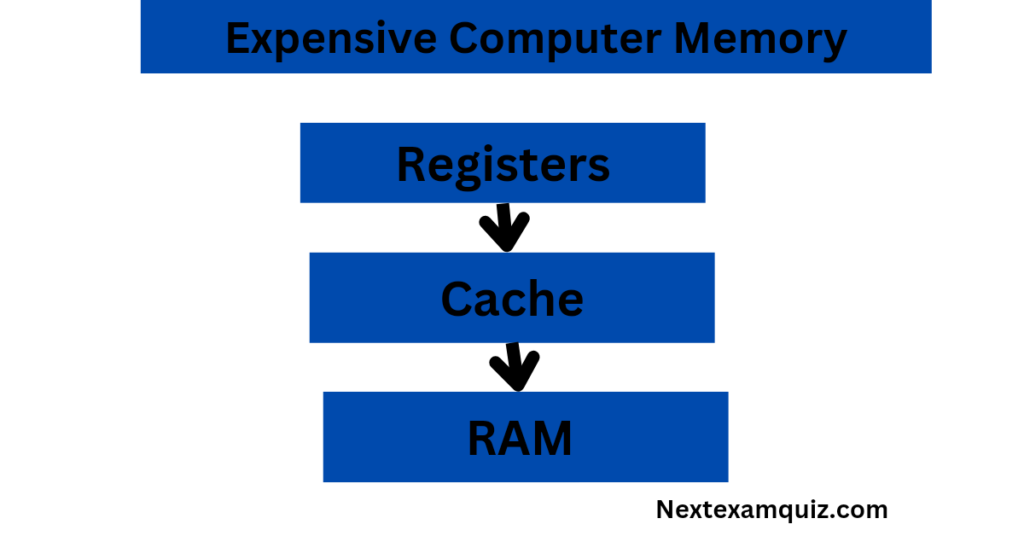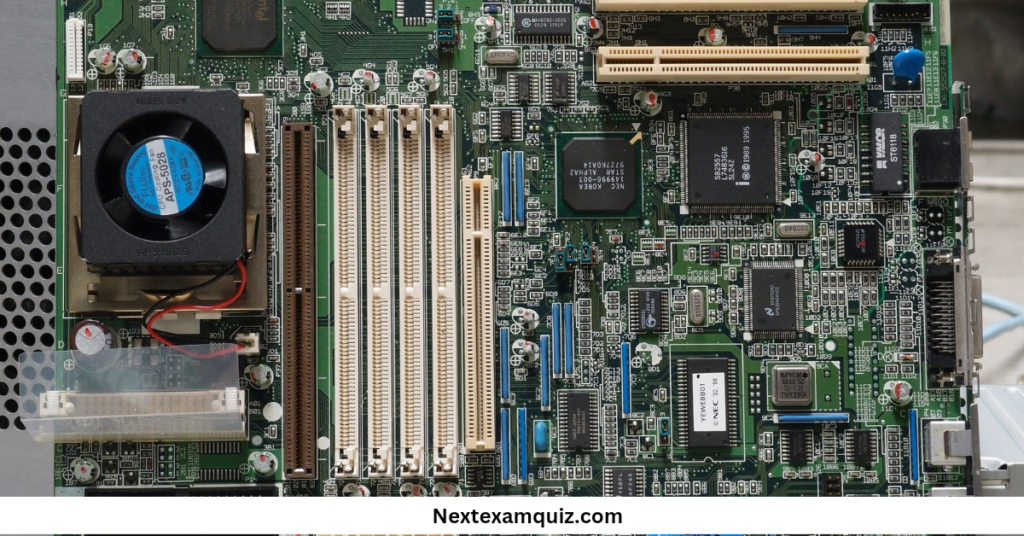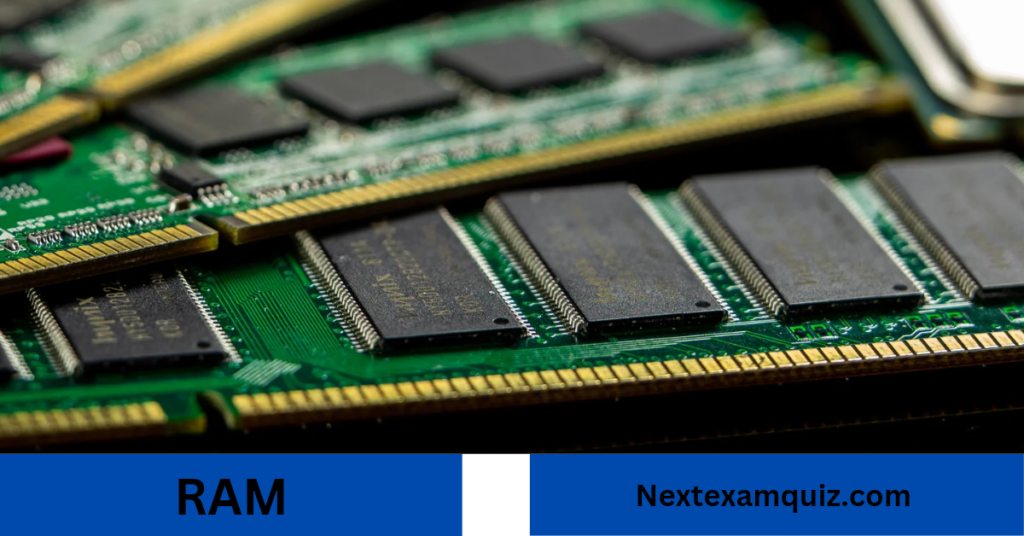
Computer Memory is like the human brain. It is used to store data and instructions in the computer system. Computer memory holds the instructions that the CPU needed for further processing. The smallest memory unit is called Bit. i.e Binary Digits. The place where these single bits are stored is called FLIP FLOPS. FLIP FLOP stores one bit of data at a time. The collection of two bits or two or more bits is called registers.

REGISTER: Register is one of the small sets and high-speed storage areas in the CPU. It is temporary processing that stores the instruction. The register is a set of integrated FLIP FLOP. The register is the smallest and fastest memory in a computer. Registers are temporary memory or primary memory. It is not a part of the main memory. The register is located inside the CPU. The register is the smallest data-holding element inside the CPU. The register holds frequently used data. Registers are temporary storage. It holds a small amount of data around 32 bits to 64 bits. The size of the register depends upon the size of the processor. The register is a volatile and fastest memory.
Why REGISTERS are faster than Main memory?
Registers are temporary storage area/memory that are located inside the processor instead of the main memory, so due to this reason data can access quickly and faster from the processor. It is easier and quicker than any other memory in the computer.
CACHE MEMORY: Cache memory is a high-speed memory located between the CPU and the main memory. It is the fastest memory. It is used to hold that part of data and programs that is frequently used by the CPU. It is the most expensive memory after the Registers. It is volatile memory. It acts as a buffer between the RAM and CPU. It is used to reduce the average access time of the CPU. CPU searched data in REGISTER, REGISTER search the data in CACHE MEMORY, CACHE MEMORY search the data in MAIN MEMORY and MAIN MEMORY search the data in SECONDARY MEMORY. The parts of the programs are transferred from the disk to the cache memory by the operating system.
Advantages of the Cache Memory:
The advantages of cache memory are as:
- Cache Memory is faster than Main memory.
- The speed of accessing data increases in the CPU due to which the CPU works faster.
- The data and programs stores that stores in the cache memory help to execute within seconds of time.
- It is used to store data for temporary work.
Disadvantages of Cache Memory:
Following are the disadvantages of Cache memory are as:
- It is very expensive compared to the Secondary storage device.
- Cache memory has limited storage capacity.
COMPUTER MEMORY

COMPUTER MEMORY is of two types.
- Primary Memory
- Secondary Memory
- PRIMARY MEMORY: Primary Memory is also called MAIN MEMORY, SIMPLE MEMORY, or INTERNAL MEMORY. Primary memory is also called internal memory. It is used for processing data. Primary memory is very close to the CPU. It stores millions and billions of data. Primary memory is very expensive compared to secondary memory. The speed of the primary memory is very faster than the secondary memory. Primary memory is located in the motherboard of the system. The motherboard also called PCB is the Printer Circuit Board. It is directly connected to the CPU. It is further divided into two parts.
- RAM
- ROM
- RAM(RANDOM ACCESS MEMORY): RAM stands for Random Access Memory. It is used for storing the data when there is currently working on. It is used to store the data and instructions when there is power is on and when the power is off the data stored in the RAM gets lost. It is read and writes memory. RAM is an example of semiconductor memory. RAM is a volatile memory. It is called volatile memory because it needs continuous power. If power is turned off then the data is lost from the RAM. RAM is a temporary memory.

TYPES OF RAM(RANDOM ACCESS MEMORY)
- SRAM
- DRAM
- SDRAM
- SRAM(STATIC RAM) SRAM stands for Static Random Access Memory. Static RAM is made up of FLIP FLOP. Static RAM is capable of retaining the stored data and information as long as the power is on. It does not require refreshments. Static RAM is very fast and it is more expensive than Dynamic RAM. STATIC RAM is used as cache memory. It data gets lost when the light becomes off.
- DRAM(Dynamic RAM): DRAM stands for Dynamic RAM. Dynamic RAM requires refreshments regularly. This memory is used for computer memory. It is made up of transistors and capacitors. This memory loses its data in a very short period of time. It is used nowadays in computers.
- SDRAM(SYNCHRONOUS DYNAMIC RAM): SDRAM stands for synchronous Dynamic Random Access Memory. It is used in every modern processor. It is an improvement to standard DRAM. It synchronizes itself with the computer’s system clock.
TYPES OF SDRAM:
- DDR1
- DDR2
- DDR3
- DDR4
DDR stands for Double Data Rate
- ROM(Read Only Memory). ROM stands for Read-only Memory. ROM is a non-volatile memory. It is used to read the data only. We cannot write in the ROM. We can only read from the ROM. ROM is used by our computers when we just turn on our computers. It contains BIOS. BIOS stands for Basic Input Output System. It is a permanent memory. It is used for storing the instructions at the time of manufacturing for the start of the computer. The content of the ROM cannot be allowed altered or overwritten. Data stored in ROM cannot be modified. Data and instructions written in the ROM is called Firmware. ROM holds instructions used for booting the computer.
TYPES OF ROM
- PROM
- EPROM
- EEPROM
- PROM(PROGRAMABLE READ-ONLY MEMORY) PROM stands for Programmable read-only memory. PROM is used for recording the information only once. when the PROM chip is programmed once, it cannot be altered again. It is also called OTP i.e. One Time Programmable.
- EPROM(Erasable PROM) EPROM stands for Erasable PROM. For reprogramming, this memory used ultraviolet light. When we want to reprogram this memory we cannot alter some portion of this memory. Here it needs to reprogram the entire memory.
- EEPROM(ELECTRICALLY ERASABLE PROM): EEPROM stands for Electrically Erasable PROM. In this memory data and instructions can be erased and reprogrammed using the Electrical signal. EEPROM chip is also called Flash ROM or Flash Memory.
Frequently Asked Questions
What is the difference between Primary Memory and Secondary Memory?
Primary Memory is used to store data and instructions on a temporary basis whereas Secondary memory is used to store data and instructions permanently. the data stored in the RAM which is primary memory gets lights off where as the data cannot get off from the secondary memory when the lights turn off.
Why RAM is called Temporary Memory?
RAM stands for Random Access Memory. RAM is called Temporary Memory because it stores the data and instructions only on a temporary basis till the light is on or the computer system is on. It is called temporary because data gets turned off when power is off even though during working.
Why ROM is called Permanent Memory?
ROM stands for Read Only Memory. ROM is called Permanent Memory because even though lights are off or on it doesn’t affect on it. It data remains to save although the lights get off during the working too.
What is Nibble?
4 Binary Digits make one Nibble.
Conclusion:
Computer Memory may be temporary or permanent it is very important for storing data like human beings retain the data or store the data in their minds. Primary memory stores the data temporary basis whereas secondary memory stores the data permanently. Primary memory stores the data while working. Primary memory is Faster and more expensive memory.
Thanks for visiting!!